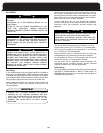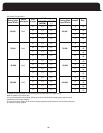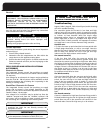
meter test dial is:
W
here:
Input is expressed in BTU/Hr.
Heating value of the gas is expressed in BTU/ ft
3
Time means time required for the test dial to indicate 1 ft
3
/sec.
I
f using a gas meter with SI (metric) units:
1 ft
3
= 0.0283 m
3
1 m
3
= 35.315 ft
3
0.01 m
3
= 0.3531 ft
3
0.5 m
3
= 1.766 ft
3
TABLE 7: INPUT VALUES
HEATING VALUE OF NATURAL GAS in BTU / FT_
00 950 1000 1050 1100
860 44,186 46,512 48,837 51,163
605 61,860 65,116 68,372 71,628
,023 119,302 125,581 131,860 138,140
Heating Value of Gas X 3000
T
I
nput =
Bonnet Output
1.085 x T
Airflow (CFM) =
IMPORTANT: NEVER ADJUST THE INPUT OF THE FURNACE
TO EXCEED THE INPUT SHOWN ON THE RATING PLATE.
when the furnace is operating with both stages of heat
on. If a higher temperature rise is desired, refer to the dip
switch settings for “Heating”. This can be adjusted to
Nominal-Plus to reduce the air temperature rise or
N
ominal-minus to increase the air temperature rise.
AIRFLOW
F
or proper furnace operation, airflow over the heat
e
xchanger is of utmost importance. Insufficient airflow
accelerates metal fatigue and failure in the heat exchanger
and excessive airflow promotes accelerated corrosion of the
heat exchanger.
IMPORTANT: Do not bypass this step of the start up
procedures.
Calculating Airflow
There are circumstances where it may be desirable to
know the airflow delivery through the duct system, such as
when estimating the amount of airflow available for air
conditioning. This can be done by direct measurement
with electronic or sloped manometers and velometers, or
by using the formula below.
Circulating Air Blower And Temperature Rise Check
variable speed circulation air blower motor that will supply
a constant airflow when operated within the external stat-
ic pressure limits of the unit. One of the benefits of a vari-
able speed circulation air blower is soft starting and stop-
ping. The motor will ramp up to normal operating speed
gradually. This will minimize noise and increase comfort by
eliminating the initial blasts of cooler air encountered with
constant speed motors. At the end of a heating or cooling
cycle, the variable speed motor will slowly ramp down
after the blower off delay timer expires. If the fan is set to
operate as a continuous blower, the motor will slowly ramp
down to the airflow set for that mode.
Temperature Rise Check
When the duct system is complete and the air filters are in
place, determine the air temperature rise of the furnace.
Insert a duct thermometer in the supply air duct. The ther-
mometer should be placed as close as practical to the fur-
nace, but out of the “line of sight” of the heat exchanger
so to prevent a false reading due to radiated heat. Ensure
that the thermometer is within the duct air-stream. Avoid
locations such as the inside radius of an elbow
, etc.
Insert a duct thermometer into the return duct as close to
the furnace as possible. Ensure that the thermometer loca-
tion will be unaffected by humidifier bypass ducts, etc.
Choose a location that ensures the thermometer will be
within the air-stream of the duct. Operate the furnace long
enough to obtain a steady state condition.
When the two thermometers have stabilized, compare the
two readings. Subtract the return air duct temperature
from the supply air duct temperature. This difference is
the temperature rise.
TABLE 7: INPUT VALUES
HEATING VALUE OF NATURAL GAS in BTU / FT_
MODEL
INTERVAL TO
CONSUME 1 FT_
(SECONDS)
900 950 1000 1050 1100
GTM050C 72 41,860 44,186 46,512 48,837 51,163
GTM070C 51 58,605 61,860 65,116 68,372 71,628
GTM135C 27 113,023 119,302 125,581 131,860 138,140
Heating Value of Gas X 3000
Time in Sec. or 1 cu. ft.
Input =
Bonnet Output
1.085 x T
Airflow (CFM) =
Where:
CFM is airflow in cubic feet per minute
∆T is the temperature rise
Bonnet output is the furnace output capacity from the
rating plate.
NOTE: The bonnet output will vary directly with the input.
If the actual input is below the stated input, the output will
be reduced in the same ratio.
Adjusting Dip Switches
If the blower speeds require adjusting, follow these steps:
1.
Remove the blower compartment door.
switches/jumpers and select the appropriate settings
3. DIP switches or jumpers are found on the integrated
furnace control board.
NOTE: some integrated furnace controls are equipped
with jumpers for blower adjustments. Please reference
“Letter” on adjustment table and control board when
making adjustment.
4. Re-install the blower compartment door.
5. Upon completion, recheck the furnace temperature rise
to ensure that the desired condition exists.
WARNING
DISCONNECT THE ELECTRICAL SUPPLY TO THE FURNACE
BEFORE ATTEMPTING TO CHANGE THE BLOWER SPEED.
F
AILURE TO DO SO COULD RESULT IN ELECTRICAL SHOCK
RESULTING IN PERSONAL INJURY OR LOSS OF LIFE.
2. Refer to the tables next page for adjusting DIP
The FV95A series 2-stage gas furnace is supplied with a
The formula for determining the furnace input via the gas A temperature rise within 35-65 degrees F is acceptable
35
ime in Sec. for 1 cu. ft.


















